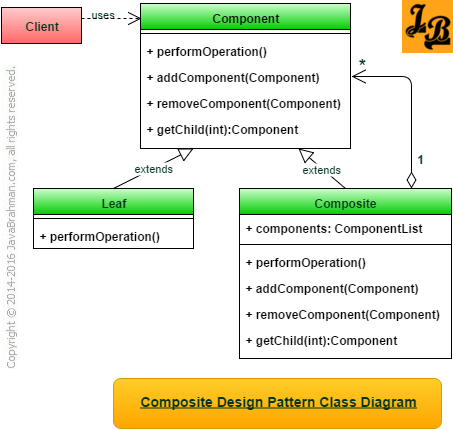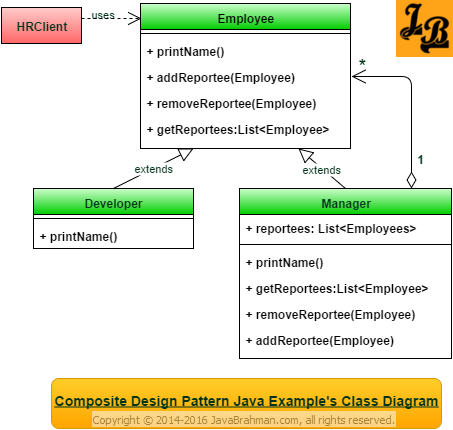Composite Design Pattern in Java
This article explains Composite design pattern in java with UML class diagram. It then takes an example scenario in java and explains it with class diagram and code.
Introduction Composite Design Pattern is a structural design pattern among the Gang Of Four(GOF) Design PatternsArticle on GOF Patterns & their types. Being a structural design pattern, the Composite pattern deals with how the classes are composed to together to fulfill the functional objectives. What is Composite Design Pattern
Class Diagram for Composite Design Pattern

Explanation of Composite Design Pattern's Class Diagram
 Code for the classes shown in Java Example's Class Diagram
Output on running HRClient.java
Code for the classes shown in Java Example's Class Diagram
Output on running HRClient.java
Explanation of Java Example's Class Diagram & Code
The Java class diagram above depicts Composite Design pattern implemented for a Manager-Developer hierarchy. Lets quickly go through whats there in Java's example's class diagram & corresponding code -
Summary
In the above tutorial we understood what is Composite design pattern and the main scenarios in which it is applicable. We then looked at the UML class diagram for Composite Design Pattern & its explanation, a Java Use Case implementing Composite pattern with its class diagram and code for the classes shown in the class diagram, followed by explanation of both the class diagram & code. This concludes the tutorial on Composite design pattern.
Introduction Composite Design Pattern is a structural design pattern among the Gang Of Four(GOF) Design PatternsArticle on GOF Patterns & their types. Being a structural design pattern, the Composite pattern deals with how the classes are composed to together to fulfill the functional objectives. What is Composite Design Pattern
- Composite Design pattern is ideal for designing a system where part-whole hierarchies exist, and where the part and the whole components are to be treated in the system uniformly.
- Composite design pattern treats both the parts and the whole in the same way. This is very beneficial for handling hierarchical part-whole hierarchies which are recursive in nature.
- Consider a binary tree. The left sub-tree and right sub-tree are themselves full-fledged binary trees. Traversals of these trees is recursive in nature due to this part-whole similarity.
- Another ubiquitous example is a UML editor, every element of the diagram is treated(drawn) in the editor the same way as the whole UML diagram.
- Part-whole hierarchy exists: The system's objects are related in a part-whole hierarchy i.e they have multiple parts being composed together to form an aggregate whole.
- Same treatment required for part and whole objects: The system treats the objects representing the part and the whole in the same way as it processes them. Considering a hierarchy such as a binary tree where lowest level nodes point to the root of the sub-tree. At the next level multiple such sub-trees now become parts of the next level sub-tree's root. So, as we move up whole objects come together as parts of the next level whole. This is hierarchical part-whole relationship. Since, the role the same individual node plays changes from part to whole - we inherently need to treat the node which plays both the roles the same way aiding in their recursive traversal.

Explanation of Composite Design Pattern's Class Diagram
- Leaf class represents the leaf node in a part-whole hierarchy.I.e. leaf nodes are those which do not have any children and typically play the role of part in part-whole hierarchy.
- Composite represents the aggregate of Components i.e. the whole side of the relationship. It holds an aggregate of Components\parts and its itself a Component. This results in a recursive relationship as the whole is composed of parts which themselves can hold their own parts.
- Component is the common base class for the Leaf and the Composite. This common base class results in the similarity between part and whole components. They, essentially, are now of the same type. And hence, the system treats them equally.
- Client uses this part-whole hierarchy to get the desired outcome from the system.

Employee.java
import java.util.ArrayList;
import java.util.List;
import javax.naming.OperationNotSupportedException;
public class Employee {
protected String name;
protected List<Employee> reportees;
public void printName(){
System.out.println("Employee Name is:"+ name);
}
public void addReportee(Employee emp) throws OperationNotSupportedException{
if(reportees==null){
reportees=new ArrayList<Employee>();
}
reportees.add(emp);
}
public void removeReportee(Employee emp)throws OperationNotSupportedException{
reportees.remove(emp);
}
public List<Employee> getReportees()throws OperationNotSupportedException{
return this.reportees;
}
//getter & setter for variable 'name'
}Manager.java
public class Manager extends Employee{
public void printName(){
//prints own name
System.out.println("Manager\n-------------");super.printName();
//prints all reportees names
System.out.println("Reportees\n-------------");
reportees.forEach(employee -> employee.printName());
}
}Developer.java
import java.util.List;
import javax.naming.OperationNotSupportedException;
public class Developer extends Employee{
public void addReportee(Employee emp)throws OperationNotSupportedException{
throw new OperationNotSupportedException();
}
public void removeReportee(Employee emp)throws OperationNotSupportedException{
throw new OperationNotSupportedException();
}
public List<Employee> getReportees()throws OperationNotSupportedException{
throw new OperationNotSupportedException();
}
}HRClient.java (with the main() method)
import javax.naming.OperationNotSupportedException;
public class HRClient {
public static void main(String[] args) {
Developer dev1 = new Developer();
Developer dev2 = new Developer();
Developer dev3 = new Developer();
dev1.setName("tom hardy");
dev2.setName("dick tracey");
dev3.setName("harry ford");
Manager manager = new Manager();
manager.setName("Mike Mitchel");
try {
manager.addReportee(dev1);
manager.addReportee(dev2);
manager.addReportee(dev3);
}catch (OperationNotSupportedException onse) {
onse.printStackTrace();
}
manager.printName();
}
}Manager ------------- Employee Name is:Mike Mitchel Reportees ------------- Employee Name is:tom hardy Employee Name is:dick tracey Employee Name is:harry ford
Explanation of Java Example's Class Diagram & Code
The Java class diagram above depicts Composite Design pattern implemented for a Manager-Developer hierarchy. Lets quickly go through whats there in Java's example's class diagram & corresponding code -
Employeeclass represents the component, or the commonality, between all objects in the system. All individuals working in a company are employees regardless of their position in the hierarchy.Manageris the composite i.e. he heads a team of developers who report to him.Developeris the leaf node in the hierarchy i.e. he doesn't have any reportees.HRClientneeds to print the names of all managers and their employees.- In the
main()method ofHRClientthe employee'sprintName()method is invoked which internally prints all his reportee employee's names as well. - While printing the
Managerand hisDeveloperreportees'printName()method is called which is there in theEmployeebase class. Thus both the manager(whole) and his developers(parts) are treated the same way in the system. This is what the Composite Pattern also mandates.
Gang of Four (GOF) Design Patterns on JavaBrahman
Creational Patterns: Factory method PatternFactory Method Design Pattern in Java Builder PatternBuilder Design Pattern in Java Prototype PatternPrototype Design Pattern in Java
Behavioral Patterns: Chain of Responsibility PatternChain of Responsibility Design Pattern in Java Observer PatternObserver Design Pattern in Java Iterator PatternIterator Design Pattern in Java State PatternState Design Pattern in Java Memento PatternMemento Design Pattern in Java Visitor PatternVisitor Design Pattern in Java Strategy PatternStrategy Design Pattern in Java Template Method PatternTemplate Method Design Pattern in Java
Structural Patterns: Adapter PatternAdapter design pattern in Java Composite PatternComposite Design Pattern in Java Facade PatternFacade Design Pattern in Java Proxy Pattern Java Proxy Design Pattern in Java
Analysis of Patterns: Strategy vs State PatternStrategy Design Pattern versus State Design Pattern
Creational Patterns: Factory method PatternFactory Method Design Pattern in Java Builder PatternBuilder Design Pattern in Java Prototype PatternPrototype Design Pattern in Java
Behavioral Patterns: Chain of Responsibility PatternChain of Responsibility Design Pattern in Java Observer PatternObserver Design Pattern in Java Iterator PatternIterator Design Pattern in Java State PatternState Design Pattern in Java Memento PatternMemento Design Pattern in Java Visitor PatternVisitor Design Pattern in Java Strategy PatternStrategy Design Pattern in Java Template Method PatternTemplate Method Design Pattern in Java
Structural Patterns: Adapter PatternAdapter design pattern in Java Composite PatternComposite Design Pattern in Java Facade PatternFacade Design Pattern in Java Proxy Pattern Java Proxy Design Pattern in Java
Analysis of Patterns: Strategy vs State PatternStrategy Design Pattern versus State Design Pattern